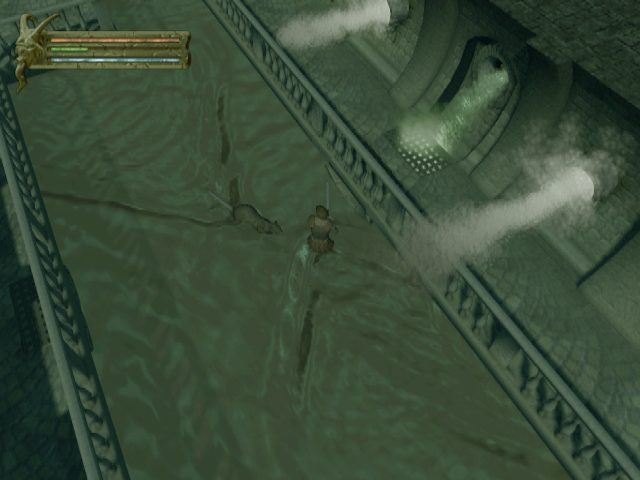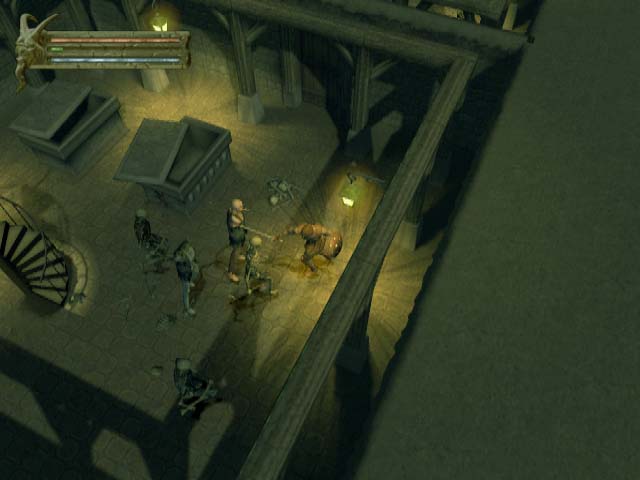 |
Baldur's Gate: Dark Alliance - Reader Review |
 |
A Fine Mixture of Classic AD&D and Dungeon Hacking
By: Rebecca Phoa
| Review Breakdown |
| Battle System |
8 |
| Interface |
8 |
| Music/Sound |
8 |
| Originality |
7 |
| Plot |
5 |
| Replay Value |
9 |
| Visuals |
9 |
| Difficulty |
Medium to Hard |
| Time |
10-26 hours
|
|
| Overall |
 |
| Criteria
|

|
| |
Since its beginnings, the classic Advanced Dungeons and Dragons (AD&D) role-playing rules has seen many incarnations in electronic game form starting with early AD&D games such as the original Strategic Simulations (SSI) published Pool of Radiance, which spawned other SSI published AD&D games, the starting of the popular Gold Box games, and some ill creations published by Interplay when they first received the AD&D license. In 1998, a Canadian developer named Bioware, created an AD&D Forgotten Realms role-playing computer game to be published by Interplay, called Baldur's Gate. Baldur's Gate became an instant success with both veterans of AD&D and new people to AD&D, by faithfully incorporating as much of the AD&D second edition rules as they could, along with spells, creatures, and more than several joinable non-player characters. However Bioware was not without help, as Interplay's role-playing game division Black Isle Studios, also put much into the project as well, providing the game with excellent voiceovers, music, and other processes. Baldur’s Gate spawned an expansion for the original Baldur’s Gate, a sequel, and an ending expansion for the Baldur’s Gate series. In the midst of the Baldur's Gate hype, Black Isle released their own AD&D titles starting with Planescape: Torment, followed by Icewind Dale which spawned two expansions. These games met similar success with AD&D veterans and AD&D newcomers. With the ending of the Baldur's Gate series, Black Isle Studios reappeared to make an AD&D splash once again - on a console. Using only the namesake of the game that started it all, Baldur's Gate: Dark Alliance created by North American developer Snowblind Studios, is an action role-playing game that incorporates elements from the newly designed AD&D third edition rules, great sound, graphics and music, but an overall thin plot even from a dungeon crawl perspective.
Even though the game incorporates the AD&D third edition rules, since it only lets you use three pre - generated player characters in the beginning, the lack of pure character customization can have a negative effect on people who wanted to heavily customize. In keeping with the rules, the armor class calculations have been "mainstreamed" leading to positive numbers rather than the negative numbers. In not keeping with the rules, Snowblind Studios did have to take some liberties by not adding in the spell casting negatives for the Elven Sorceress because of heavy armor for game balance. For difficulty settings, there are three, ranging from Easy, Normal, and Hard. For creatures, familiar AD&D foes were added such as Frost Giants, and Bulettes. Also stock creatures such as kobolds and spiders are never far and few between. The only drawback to fighting these classic AD&D enemies is that the creature artificial intelligence (AI) is very much set to a chase-the-player mode with little usage of tactics in between. This AI subsequently leads to some boss fights that are as a result unchallenging, even in the last stages of the game. Levelling up in the game is not difficult because defeating all the monsters in a given area is a large part of the game. This all leads to the game's most important factor in gaining levels as skill points are given in increasing amounts to allocate to a selected list of feats and spells for each player character. Such feats and spells are either active or passive, unlike the AD&D rules though, active feats are subjected to a mana pool rather than a set number of uses per day. Every few levels an extra statistical point can be allocated to a statistic of a player's choosing.
For user friendliness, there is a medium learning curve for the player, as the game uses all the buttons including the digital direction pad and both the analog sticks for comfortable control. Similarly, since there is no auto-locking feature for long-range weaponry, fighting with a bow gets inaccurate unless practiced regularly. Needless to say, controls are a handful. Other than these drawbacks, gameplay is smooth and runs very well. There is no game slowdown and load times are not a problem. Another nice aspect of gameplay is that the dual shock controller will simulate a fast-paced heartbeat to indicate to a player that his/her player character is critically injured without looking at the health bar.

|
| Medium sized rats and very nice water effects are in this game
|
|
Music and sound wise, it is impressive. Black Isle Studios spared no expense in obtaining Jeremy Soule for the game's music. One of the first pieces you hear is the Elfsong Tavern's haunting music, which is both pleasant and mysterious. Music becomes faster paced but well orchestrated during boss battles, and each piece fits each location well. Jeremy Soule in the past was responsible for creating music for Total Annihilation, Icewind Dale, Giants: Citizen Kabuto, Secret of Evermore, and Azurik: Rise of Perathia. Also provided are good sound effects for smashing barrels, crashing porcelain pots, weapon/armor clanging, loud crashes for large falling creatures such as the ever increasingly large golems in the game, and ambience. As well, the voice acting is well done. Black Isle managed to obtain voice actors/actresses who had done past Baldur's Gate games and other popular titles/formal acting. Some notables include Kevin Michael Richardson, Jim Cummings, Jennifer Hale, Michael Bell, Cam Clarke, Jeff Bennett, and John Rhys-Davies.
Since Baldur's Gate: Dark Alliance is a hack and slash, it is as simple a game a developer could create in an role-playing game setting. It resembles Diablo II in many ways because of the isometric, overhead perspective. The game's originality comes from the characters the player can choose from since they do require different battle tactics at times. The Dwarven Fighter is a very good beginner class as a player can easily go toe-to-toe with the majority of enemies with the odd Bull Rush feat. The Elven Sorceress will be required to go toe-to-toe, until spells are obtained in which a mixture of both melee and long-range attacks can be used. The Arcane Archer is an interesting mix of both of these extremes, being able to set off magical arrow feats similar to a Sorceress' spells, but does a better job in melee fighting than the Sorceress because of higher hit points and strength. However, people may find that such individuality may taper off at some point in the game, as all characters can be easily outfitted in the same manner. Added in the game is a two-player coop option, that is structured around two people using different characters. It is a fun diversion for people wanting to include a friend as importing characters is very easy to do. In fighting certain undead creatures, one interesting element added in the game was that a player could defeat a zombie, only to see half of the creature rise up again and crawl around and continue the fight. Also since Snowblind Studios took the liberty of allowing the player to randomly hack off appendages, certain undead creatures will still be walking around, even the beheaded type. Baldur's Gate: Dark Alliance is certainly not a children's title, but having such elements can delight an older audience.
Concerning the game's storyline, it is a mixed bag. In fact, the plot is such that it starts off strongly by starting the game in an interesting, mysterious way when the player suddenly gets waylaid and robbed by a small gang of thieves in the city of Baldur's Gate. The game then continues that strength throughout the first chapter. In the second chapter, the plot becomes very thin; not much is said about the situations present in that area. In the third chapter while it does have a small pickup, a lot of the story in the chapter is spoiled by it being presented in the game's manual.

|
| The player will fight many hordes of the undead throughout the game |
|
Since there are three characters to choose from, there is foreseeable high replay value and Baldur's Gate: Dark Alliance may require at least another go for complete enjoyment. In fact once the game is finished with one character, a person may want to have another run through with a different character just for different tactics, or a different difficulty level. Finishing the game will also net the player a few bonuses that are real treats for AD&D fans, and just might pique the interests of newcomers into AD&D.
Visually, Baldur's Gate: Dark Alliance does not disappoint. As a game on a next generation console system, the environments are beautiful. Light from nearby torches flare and light up the small radius the torch is in, and the water effects ripple dynamically when either the player or enemies walk in the game’s many pools. In fact, the water effects in the game were created so well that it doesn't matter whether you are walking in a town's fountain or a swamp to see that the water is easily the game's greatest graphical achievement. The game’s buildings, sewers, caves, and swamps are well textured, and spell effects are bright and brilliant when hitting creatures or splashing against objects. Glowing magical weaponry is a nice touch for those people used to having glowing magic weapons in the computer AD&D games. Also present in the game are the real-time scenes that are well done. Non-player characters in the game were also animated for speech and gestures, which do give a sense of that character talking to you and brings the player into the game. Sometimes however such nice graphics come with a price; since the game loads in textures constantly, a person may find that parts of the scenery do not appear when the camera is rotated. Also but highly rare, the game may freeze due to high amounts of particle effects going off at once.
Baldur's Gate: Dark Alliance's difficulty can vary due to its initial three settings which determines how much damage enemies can deal out. Even on Normal mode however, certain enemies can be questionably tough, but players will have a good variety of means to deal with the threats by using their feats and weapons. Even though the game is split into three acts, Baldur's Gate: Dark Alliance is a shorter game than most. Some players can finish it the first time through in roughly 10 to 26 hours.

|
| Displacer Beasts appear whenever and wherever they please |
|
Baldur's Gate: Dark Alliance overall is a great game with stunning visuals, solid gameplay, good sound, and great music. It's also a lot of fun to play, with plenty of replay options for either a single person or two. It is quite pleasing that Baldur's Gate: Dark Alliance turned out the way it did because while it is a very different game from the other AD&D computer games, it's a game that has the potential to grow into a highly popular and well made series.
|










